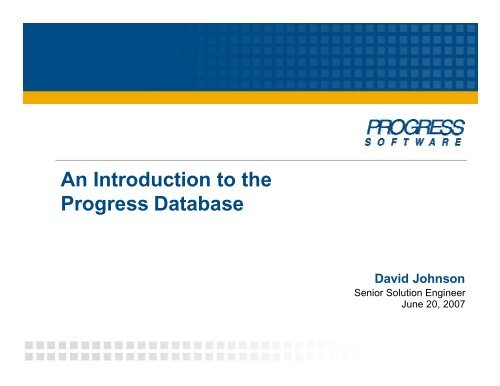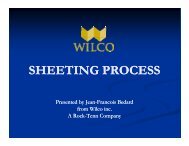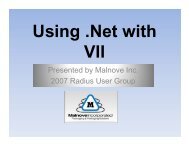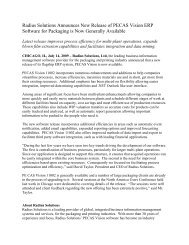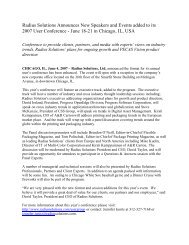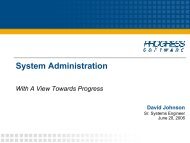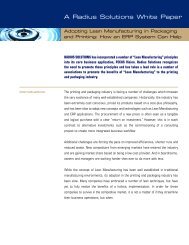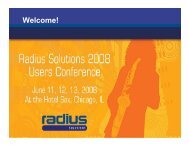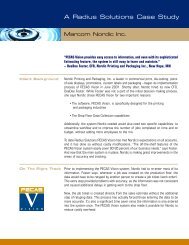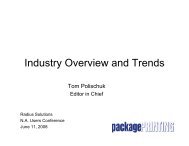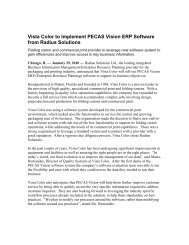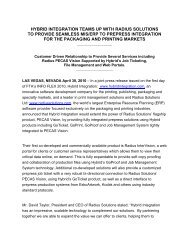An Introduction to the Progress Database - Radius
An Introduction to the Progress Database - Radius
An Introduction to the Progress Database - Radius
Create successful ePaper yourself
Turn your PDF publications into a flip-book with our unique Google optimized e-Paper software.
<strong>An</strong> <strong>Introduction</strong> <strong>to</strong> <strong>the</strong><br />
<strong>Progress</strong> <strong>Database</strong><br />
David Johnson<br />
Senior Solution Engineer<br />
June 20, 2007
Agenda<br />
• <strong>Database</strong> Basics & Architecture<br />
• Creating, Starting, S<strong>to</strong>pping a <strong>Database</strong><br />
• Backup & Res<strong>to</strong>re<br />
• Dump & Load<br />
• Basic Tuning<br />
• Moni<strong>to</strong>ring & Replicating Data<br />
2<br />
© 2007 <strong>Progress</strong> Software Corporation
What Is a <strong>Database</strong> Management System<br />
• Software that<br />
• Organizes and integrates data<br />
• Shares data<br />
• Provides <strong>the</strong> ability <strong>to</strong><br />
– Create,<br />
– Retrieve,<br />
– Update,<br />
– and Destroy data contained in <strong>the</strong> database<br />
• Manages <strong>the</strong> s<strong>to</strong>rage devices that contain data<br />
• Handles error recovery when something goes<br />
wrong<br />
3<br />
© 2007 <strong>Progress</strong> Software Corporation
Objectives of an RDBMS<br />
• Quick & Efficient access <strong>to</strong> Entity Relational Data<br />
A<br />
F<br />
B<br />
S<br />
R<br />
B<br />
O<br />
C<br />
U<br />
B<br />
O<br />
X<br />
G<br />
L<br />
A<br />
Z<br />
X<br />
U<br />
E<br />
R<br />
Y<br />
C<br />
S<br />
S<br />
A<br />
F<br />
B<br />
X<br />
B<br />
O<br />
A<br />
Y<br />
C<br />
O<br />
R<br />
Z<br />
A<br />
X<br />
B<br />
Y<br />
C<br />
Z<br />
Data On<br />
Disk<br />
Information<br />
In Memory<br />
Knowledge<br />
On Client<br />
4<br />
© 2007 <strong>Progress</strong> Software Corporation
Why use a RDBMS<br />
• Lets you take for granted <strong>the</strong> following:<br />
• Find what you need quickly<br />
• Allow shared access <strong>to</strong> <strong>the</strong> data<br />
• Coordinate concurrent updates <strong>to</strong> <strong>the</strong> same<br />
records<br />
• Enforce security rules<br />
• Ensure structural integrity<br />
• Provide high performance<br />
• Correct <strong>the</strong> data when errors occur<br />
• Perform crash recovery<br />
• Map data structures <strong>to</strong> compact s<strong>to</strong>rage<br />
• Add new data definitions on-line<br />
• <strong>An</strong>d more…<br />
5<br />
© 2007 <strong>Progress</strong> Software Corporation
<strong>Database</strong> S<strong>to</strong>rage<br />
Logical View<br />
• Area: A group of database objects<br />
(tables, indexes)<br />
• Table: A set of records (rows) that are<br />
composed of fields (columns)<br />
• Field: A single data value (or array)<br />
• Index: <strong>An</strong> ordered list of key value-rowid pairs<br />
that identify all rows in a table<br />
• Index entry: one key value-rowid pair<br />
6<br />
© 2007 <strong>Progress</strong> Software Corporation
S<strong>to</strong>rage Areas (<strong>Progress</strong> V9)<br />
Logical<br />
View<br />
Table A<br />
Table B<br />
Index A-1<br />
Index B-1<br />
Table C<br />
Table D<br />
Index C-1<br />
Index D-1<br />
Index E-1<br />
Table E<br />
Index E<br />
Area 6 Area 7 Area 8<br />
Area 51<br />
Physical<br />
View<br />
Extent<br />
Extent<br />
Extent<br />
Extent<br />
Extent<br />
Extent<br />
Extent<br />
Extent<br />
Extent<br />
Extent<br />
Disk S<strong>to</strong>rage - Files or Raw Slices<br />
7<br />
© 2007 <strong>Progress</strong> Software Corporation
<strong>Database</strong> S<strong>to</strong>rage<br />
Physical View<br />
• Block: A fixed-size unit of disk I/O and s<strong>to</strong>rage. All<br />
data areas have same block size.<br />
• Extent: A unit of disk s<strong>to</strong>rage<br />
• Ei<strong>the</strong>r a file or a raw disk slice<br />
• May be fixed or variable size<br />
• Area: A group of physical s<strong>to</strong>rage objects<br />
8<br />
© 2007 <strong>Progress</strong> Software Corporation
<strong>Database</strong> Blocks within Extents<br />
Fixed extent<br />
Cluster<br />
<strong>Database</strong> block<br />
Variable extent<br />
Not yet<br />
allocated<br />
by O/S<br />
Filled Partly filled Free Not yet allocated<br />
9<br />
© 2007 <strong>Progress</strong> Software Corporation
Transactions – What Are They<br />
• Transactions are an error handling and<br />
recovery mechanism. If nothing goes wrong,<br />
you don’t need <strong>the</strong>m.<br />
• Eventually, something will go wrong.<br />
• When something does go wrong, or you say<br />
“Ooops, I don’t want <strong>to</strong> do this after all.”<br />
10<br />
The transaction manager graciously puts<br />
everything back <strong>the</strong> way it was, just as if<br />
nothing had ever happened.<br />
© 2007 <strong>Progress</strong> Software Corporation
<strong>Database</strong> Transaction Logs<br />
• <strong>Progress</strong> generates two types of transaction<br />
logs:<br />
• The undo-redo log or Before-Image Log contains<br />
a record of recent changes.<br />
• The redo log or After-Image Journal contains a<br />
record of all changes since a complete backup of<br />
<strong>the</strong> database was made.<br />
• The records (also called “notes”) that are written<br />
<strong>to</strong> <strong>the</strong> two transaction logs are identical.<br />
• O<strong>the</strong>r database systems use similar<br />
techniques<br />
11<br />
© 2007 <strong>Progress</strong> Software Corporation
<strong>Database</strong> Transaction Logs<br />
BI<br />
Undo-Redo Log<br />
(Before-Image Log)<br />
Recorded Changes<br />
Original<br />
<strong>Database</strong><br />
db<br />
Transactions<br />
make changes<br />
db’<br />
Updated<br />
<strong>Database</strong><br />
AI<br />
Redo-Log<br />
(After-Image Journals)<br />
Recorded Changes<br />
12<br />
© 2007 <strong>Progress</strong> Software Corporation
<strong>Progress</strong> RDBMS Architecture<br />
Clients<br />
WebSpeed<br />
4GL Client 4GL Client<br />
AppServer<br />
ODBC<br />
JDBC<br />
ESQL/C<br />
Servers<br />
4GL<br />
<strong>Database</strong><br />
Server<br />
OpenEdge-SQL<br />
<strong>Database</strong><br />
Server<br />
Shared <strong>Database</strong> S<strong>to</strong>rage Engine<br />
13<br />
© 2007 <strong>Progress</strong> Software Corporation
Agenda<br />
• <strong>Database</strong> Basics & Architecture<br />
• Creating, Starting, S<strong>to</strong>pping a <strong>Database</strong><br />
• Backup & Res<strong>to</strong>re<br />
• Dump & Load<br />
• Basic Tuning<br />
• Moni<strong>to</strong>ring & Replicating Data<br />
14<br />
© 2007 <strong>Progress</strong> Software Corporation
Methods <strong>to</strong> Create a <strong>Database</strong><br />
‣ Using PRODB<br />
‣ Using a .ST file, PROSTRCT CREATE,<br />
and PROCOPY<br />
‣ Data Dictionary <strong>to</strong>ol<br />
‣ Data Administration <strong>to</strong>ol<br />
‣ PROREST<br />
‣ PROUTIL CONV89 | CONV910<br />
15<br />
© 2007 <strong>Progress</strong> Software Corporation
Using a .ST File, PROSTRCT CREATE, and<br />
PROCOPY<br />
1<br />
2<br />
PROSTRCT CREATE<br />
Void DB<br />
Source DB<br />
.ST File<br />
3<br />
PROCOPY<br />
Resultant DB<br />
16<br />
© 2007 <strong>Progress</strong> Software Corporation
Structure Description File<br />
• # Sampledb.st file<br />
• b .\Sampledb.b1 f 32000<br />
• b .\Sampledb.b2 f 32000<br />
• b .\Sampledb.b3<br />
• #<br />
• d "Schema Area":6,32 .\Sampledb.d1<br />
• #<br />
• d "Employee":7,32;64 .\Sampledb_7.d1 f 32000<br />
• d "Employee":7,32;64 .\Sampledb_7.d2<br />
• #<br />
• d "Inven<strong>to</strong>ry":8,32;64 .\Sampledb_8.d1 f 64000<br />
• d "Inven<strong>to</strong>ry":8,32;64 .\Sampledb_8.d2<br />
• …<br />
• a .\Sampledb.a1 f 32000<br />
• a .\Sampledb.a2 f 32000<br />
• a .\Sampledb.a3<br />
17<br />
© 2007 <strong>Progress</strong> Software Corporation
Data Dictionary & Data Administration<br />
18<br />
© 2007 <strong>Progress</strong> Software Corporation
Starting a <strong>Database</strong> Broker<br />
proserve db –H host –S service<br />
Broker<br />
Shared Memory<br />
19<br />
© 2007 <strong>Progress</strong> Software Corporation
Starting up Multiple Brokers<br />
Primary broker<br />
proserve db –Mn n<br />
SQL<br />
Broker<br />
Shared Memory<br />
Additional broker<br />
proserve db –m3<br />
4GL<br />
Broker<br />
20<br />
© 2007 <strong>Progress</strong> Software Corporation
Using a Parameter File<br />
NEWDB.PF<br />
proserve –pf newdb.pf<br />
-db newdb<br />
-H localhost<br />
-S 3000<br />
-n 101<br />
-Mn 15<br />
-Ma 5<br />
-Mpb 4<br />
-ServerType SQL<br />
…<br />
SQL<br />
Broker<br />
4GL<br />
Broker<br />
Shared Memory<br />
21<br />
© 2007 <strong>Progress</strong> Software Corporation
Shutting Down a <strong>Database</strong> in <strong>the</strong> Multi-User<br />
Environment<br />
‣PROSHUT<br />
‣Can also be used <strong>to</strong> disconnect a user<br />
‣PROMON<br />
22<br />
© 2007 <strong>Progress</strong> Software Corporation
The <strong>Progress</strong> Explorer Tool<br />
23<br />
© 2007 <strong>Progress</strong> Software Corporation
Agenda<br />
• <strong>Database</strong> Basics & Architecture<br />
• Creating, Starting, S<strong>to</strong>pping a <strong>Database</strong><br />
• Backup & Res<strong>to</strong>re<br />
• Dump & Load<br />
• Basic Tuning<br />
• Moni<strong>to</strong>ring & Replicating Data<br />
24<br />
© 2007 <strong>Progress</strong> Software Corporation
Backup & Res<strong>to</strong>re - Planning<br />
‣ Which files of <strong>the</strong> database do we need <strong>to</strong> back up<br />
‣ Which backup utility do we use<br />
‣ What impact would our backup method have on our<br />
users<br />
‣ How much data should we back up<br />
‣ What is <strong>the</strong> cost of our backup and can we afford it<br />
‣ What kind of backup media should we use<br />
‣ When and how often should we back up<br />
‣ How do we label and archive <strong>the</strong> backups<br />
‣ When and how do we test <strong>the</strong> backups<br />
25<br />
© 2007 <strong>Progress</strong> Software Corporation
OpenEdge RDBMS Backup Utility<br />
probkup [ online ] db-name<br />
[ incremental ] device-name<br />
Required files<br />
.DB<br />
.Dn<br />
.Bn<br />
Full backup or…<br />
Incremental backups<br />
26<br />
© 2007 <strong>Progress</strong> Software Corporation
Verify <strong>the</strong> Backup<br />
prorest db-name backup-file -vf<br />
Backup file<br />
.BCK<br />
27<br />
© 2007 <strong>Progress</strong> Software Corporation
Res<strong>to</strong>re <strong>the</strong> Backup<br />
prorest db-name backup-file<br />
Backup file<br />
.BCK<br />
28<br />
© 2007 <strong>Progress</strong> Software Corporation
Agenda<br />
• <strong>Database</strong> Basics & Architecture<br />
• Creating, Starting, S<strong>to</strong>pping a <strong>Database</strong><br />
• Backup & Res<strong>to</strong>re<br />
• Dump & Load<br />
• Basic Tuning<br />
• Moni<strong>to</strong>ring & Replicating Data<br />
29<br />
© 2007 <strong>Progress</strong> Software Corporation
Reasons <strong>to</strong> do a Dump & Load<br />
• Create a new version of a database<br />
• Economize disk space<br />
• Convert a database <strong>to</strong> a new OpenEdge<br />
release or a different operating system<br />
platform<br />
• Load updated data definitions <strong>to</strong> upgrade a<br />
database schema<br />
• Change <strong>the</strong> database block size<br />
30<br />
© 2007 <strong>Progress</strong> Software Corporation
S<strong>to</strong>rage after “months” of database activity<br />
extent 1 (fixed)<br />
Type I S<strong>to</strong>rage Area<br />
extent 2 (variable)<br />
Reserved Blocks<br />
Table 1 data<br />
Table 2 data<br />
Table 3 data<br />
Table 4 data<br />
Table 5 data<br />
Table 6 data<br />
1 <strong>Database</strong> block<br />
High<br />
Water<br />
Mark<br />
Total<br />
Blocks<br />
31<br />
© 2007 <strong>Progress</strong> Software Corporation
Dump and Load Process<br />
proutil db-name –C dump table-name target-dir<br />
Dump<br />
Load<br />
Source <strong>Database</strong><br />
Definitions<br />
Target <strong>Database</strong><br />
Data<br />
proutil db-name –C load .bd-file<br />
32<br />
© 2007 <strong>Progress</strong> Software Corporation
Dump & Load - <strong>Database</strong> Administration Tool<br />
Source <strong>Database</strong><br />
Data.d<br />
33<br />
© 2007 <strong>Progress</strong> Software Corporation
OpenEdge 10<br />
Type II S<strong>to</strong>rage<br />
Type I S<strong>to</strong>rage Area<br />
Type II S<strong>to</strong>rage Area<br />
Db extent (variable)<br />
Db extent (variable)<br />
High<br />
Water<br />
Mark<br />
Total<br />
Blocks<br />
High<br />
Water<br />
Mark<br />
Total<br />
Blocks<br />
Area Control Object<br />
Table 1 data<br />
Table 2 data<br />
Table 3 data<br />
1 <strong>Database</strong> block<br />
34<br />
© 2007 <strong>Progress</strong> Software Corporation
Agenda<br />
• <strong>Database</strong> Basics & Architecture<br />
• Creating, Starting, S<strong>to</strong>pping a <strong>Database</strong><br />
• Backup & Res<strong>to</strong>re<br />
• Dump & Load<br />
• Basic Tuning<br />
• Moni<strong>to</strong>ring & Replicating Data<br />
35<br />
© 2007 <strong>Progress</strong> Software Corporation
<strong>Progress</strong> <strong>Database</strong> Tuning<br />
Server startup<br />
• Buffer Pool Size<br />
• -B, Increase when buffer hit ratio < 90%<br />
• Spinlock Retry Count<br />
• -spin = 50,000 (rule of thumb), Enterprise only<br />
• Start BI Log Writer (BIW)<br />
• 1 per database, Enterprise only<br />
• Start Asynchronous Page Writer (APW)<br />
• Increase until 0 blocks flushed at checkpoint, Ent. only<br />
• Increase BI Log Block Size<br />
• -biblocksize, set <strong>to</strong> 8<br />
• Add BI Log Buffers<br />
• -bibufs, Default = 5, set in range of 25-50<br />
36<br />
© 2007 <strong>Progress</strong> Software Corporation
<strong>Progress</strong> <strong>Database</strong> Tuning<br />
Server startup cont…<br />
• Increase BI Log Cluster Size<br />
• -bi 4096<br />
• Move Data Extents <strong>to</strong> Striped Array<br />
• Move BI Log <strong>to</strong> a Separate Disk<br />
Client side<br />
• -T (Temp files)<br />
• -q (quick request)<br />
• -TM & -TB sort options<br />
37<br />
© 2007 <strong>Progress</strong> Software Corporation
Example Tuning Results<br />
throughput (tps)<br />
800<br />
700<br />
600<br />
500<br />
400<br />
300<br />
200<br />
100<br />
0<br />
30<br />
no tuning<br />
581<br />
simple tuning<br />
38<br />
© 2007 <strong>Progress</strong> Software Corporation
Agenda<br />
• <strong>Database</strong> Basics & Architecture<br />
• Creating, Starting, S<strong>to</strong>pping a <strong>Database</strong><br />
• Backup & Res<strong>to</strong>re<br />
• Dump & Load<br />
• Basic Tuning<br />
• Moni<strong>to</strong>ring & Replicating Data<br />
39<br />
© 2007 <strong>Progress</strong> Software Corporation
Moni<strong>to</strong>ring using Promon<br />
PROGRESS MONITOR Version 9<br />
<strong>Database</strong>: /FULLPATH/DBNAME<br />
1. User Control<br />
2. Locking and Waiting Statistics<br />
3. Block Access<br />
4. Record Locking Table<br />
5. Activity<br />
6. Shared Resources<br />
7. <strong>Database</strong> Status<br />
8. Shut Down <strong>Database</strong><br />
T. Transactions Control<br />
L. Resolve Limbo Transactions<br />
C. Coordina<strong>to</strong>r Information<br />
M. Modify Defaults<br />
Q. Quit<br />
Basic information<br />
can be found on screen 5<br />
Also look under R&D<br />
Go ahead and poke<br />
around; just don’t<br />
choose “Shut Down”<br />
40<br />
© 2007 <strong>Progress</strong> Software Corporation
Key performance activity metrics<br />
41<br />
© 2007 <strong>Progress</strong> Software Corporation
O<strong>the</strong>r Tools For <strong>Database</strong> <strong>An</strong>alysis<br />
Tool<br />
• Prostrct statistics<br />
• Prostrct list<br />
• Proutil dbanalys<br />
• statParse.p<br />
• VST’s<br />
• Top<br />
• Your favorite OS <strong>to</strong>ol<br />
Frequency<br />
(monthly)<br />
(as needed)<br />
(weekly or monthly)<br />
(monthly)<br />
(program dictated)<br />
42<br />
© 2007 <strong>Progress</strong> Software Corporation
Moni<strong>to</strong>ring Using Fathom Management<br />
43<br />
© 2007 <strong>Progress</strong> Software Corporation
Data Replication - Fathom Replication Plus<br />
44<br />
© 2007 <strong>Progress</strong> Software Corporation
<strong>Progress</strong> and <strong>Radius</strong> Solutions<br />
Reliable, Scalable, Efficient, Open, Cost-Effective…<br />
<strong>Progress</strong> Software has over 20 years of proven<br />
success in partnering with ISVs <strong>to</strong> ensure <strong>the</strong><br />
fastest, most cost-effective path for delivering<br />
competitive business applications.<br />
IDC<br />
“…<strong>Progress</strong> partnering approach leads <strong>the</strong> industry”<br />
Forrester reports…<br />
“…40% cost savings on <strong>the</strong> <strong>Progress</strong> platform versus an alternative platform"<br />
45<br />
© 2007 <strong>Progress</strong> Software Corporation
46<br />
© 2007 <strong>Progress</strong> Software Corporation
Why Upgrade <strong>to</strong> OpenEdge <br />
Large <strong>Database</strong> Support<br />
64 bit Rowids<br />
64 bit Sequences<br />
64 bit Integer Datatype<br />
Large Index Key Entries (1970)<br />
32,000 areas<br />
Performance<br />
Type II S<strong>to</strong>rage Areas<br />
Increased addressable shmem<br />
Larger Shmem segment support<br />
Internal pro<strong>to</strong>col enhancements<br />
Buffers, Locks, Indexing<br />
Au<strong>to</strong> Record Defrag<br />
High Availability<br />
Online Schema changes<br />
Online space management<br />
Enabled/Disable ai online<br />
Security<br />
SSL<br />
Auditing<br />
Datatype Support<br />
BLOB, CLOB<br />
Date/Time, Date/Time w/tz<br />
int 64<br />
Maintenance<br />
.st file syntax checker<br />
AI management<br />
More online maintenance<br />
Multi threaded utilities<br />
Log File<br />
New format<br />
Significant events<br />
Improved log file management<br />
Db I/O by User by Object<br />
47<br />
© 2007 <strong>Progress</strong> Software Corporation


